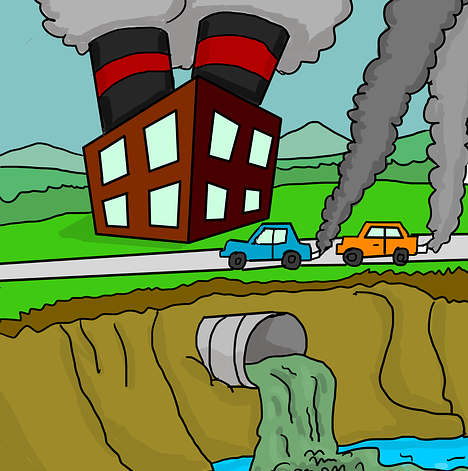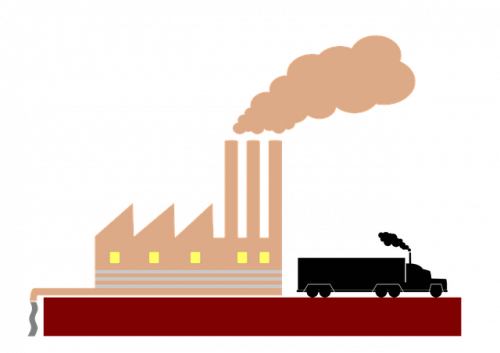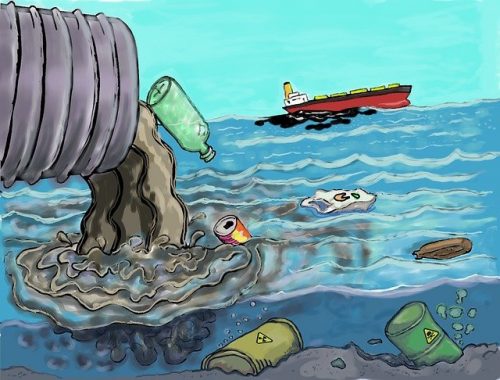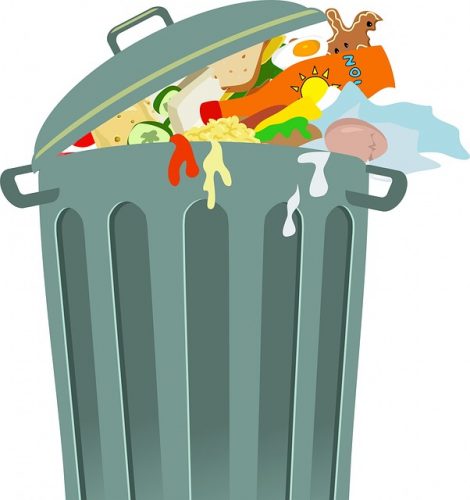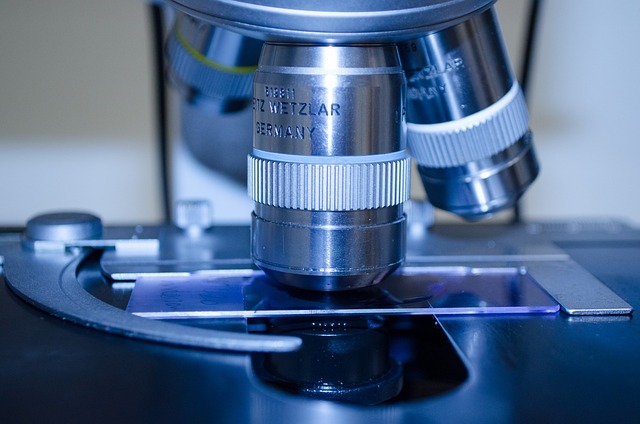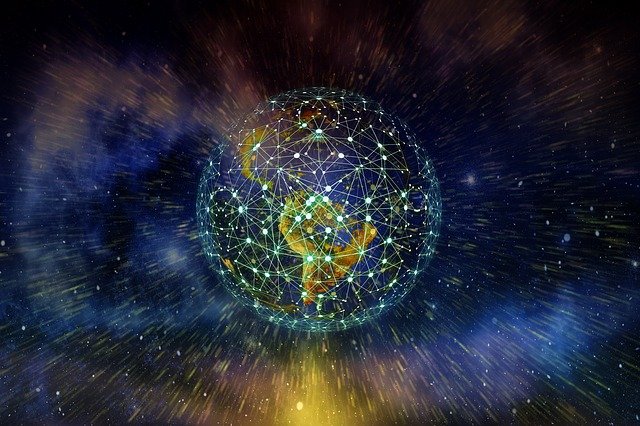Do you wish to learn more about pollution and its types? Do you want easy and brief information on air pollution, water pollution, land pollution and noise pollution as well as their common pollutants, sources, effects and control or prevention measures? If yes, then you are at the right place as today we will be discussing exact that! So read ahead!
POLLUTION:
Pollution refers to the presence of unwanted or harmful substances in the environment.
POLLUTANTS:
Unwanted or harmful substances that pollute the environment are called pollutants.
TYPES OF POLLUTION
There are 4 basic types of pollution:
1. Air pollution
2. Water pollution
3. Land pollution
4. Noise pollution
1. AIR POLLUTION
Air pollution refers to the presence of unwanted or harmful gases or particles in the air.
Sources of Air Pollution:
Different air pollutant (particles and gases) from factories, vehicle exhausts and burning of fossil fuels like coal and oil etc are released into the air which pollute the air.
Common Air Pollutants:
- Particulate matter (PM)
- Carbon Dioxide
- Carbon Monoxide
- Sulphur Dioxide
- Oxides of NitrogeN
Effects of Air pollution:
Air pollution has many negative effects on human beings and the environment. Air pollution can cause respiratory diseases and can damage the respiratory system including lungs. It can also cause breathing problems, headaches, eye and throat irritation. Air pollution like Smog (Smoke+Fog) can reduce visibility and cause traffic accidents.
Reducing Air Pollution – Control/Prevention:
Some ways in which air pollution can be reduced are:
- Planting more trees
- Walking/cycling shorter routes instead of using a car or bike
- Using public transport instead of individual cars
- Not burning agricultural waste or garbage
- Making sure factories do not release harmful gases and particles into the air.
- Your personal exposure to air pollution can be reduced by wearing a mask when going out of house.
2. WATER POLLUTION
Water pollution refers to the presence of unwanted or harmful chemicals or particles in water.
Sources of Water Pollution:
Water pollutants from different sources such as farms (pesticides and fertilizers), factories (toxic chemicals, acids, alkalis), hospitals (medicines, syringes, gloves etc) and households (cleaning products, washing soaps and powders, sewage) etc enters into water bodies like underground water, rivers, streams, lakes and eventually the sea causing water pollution.
Common Water Pollutants:
- Pesticides
- Fertilizers (Ammonia)
- Toxic chemicals/substances/elements (like Chlorine, Arsenic, Lead, Chromium etc.)
- Acids and Alkalis (like Sulphuric acid, Nitric Acid, Hydrochloric acid, Sodium Hydroxide etc.)
- Household cleaning products (like surfs, soaps, drain openers etc)
- Kitchen and bathroom waste in form of sewage (human waste from bathrooms; rotten fruits/vegetables and spoiled food from kitchens)
- Microorganisms like viruses and bacteria
- Plastics and microplastics (tiny pieces of plastics)
Effects of Water pollution:
Presence of harmful microorganisms like viruses and bacteria in drinking water can cause many diseases such as cholera, diarrhea and food poisoning etc. Toxic substances from factories like lead are cancer causing. Water with acids, alkalis or harmful chemicals can kill fishes in water bodies and also any birds or animals that drink that water. Water pollutants are extremely harmful for humans and the environment.
Reducing Water Pollution – Control/Prevention:
Some ways in which water pollution can be reduced are:
- Don’t throw garbage into water bodies
- Do not flush medicines down the toilet.
- Stop factories from releasing toxic pollutants into water bodies
- Your personal exposure to water pollution can be reduced by making sure the water you drink is clean and doesn’t not contain any pollutants.
3. LAND POLLUTION
Land pollution refers to the presence of unwanted or harmful substances or particles on land.
Sources of Land Pollution:
Some common sources of land pollution include solid waste or garbage from households and hospitals etc. Waste or sludge from industries or mining activities that is deposited on land is another source of land pollution. Mining activities and pollution caused due to construction or agricultural activities are yet another source of land/soil pollution.
Common Land Pollutants:
- Plastic waste in form of discarded single-use plastic bottle or disposable cutlery
- Sewage sludge or other solid waste generated in households
- Medical waste which is hazardous
- Rotten fruits/vegetables or spoiled food items as kitchen waste or agricultural waste.
- Waste paper/card boards/clothes
Effects of Land pollution:
Land pollution does not only destroy the beauty and aesthetics of the polluted piece of land but also negatively impacts the soil of that area. Toxins from mining pollution not only pollute land but also pollute water bodies they run off to. Garbage heaps are breeding grounds for insects causing vector-borne diseases as well as bacterial and viruses causing other diseases. Medical solid waste is hazardous and can be extremely dangerous if people or animals come in contact with them.
Reducing Land Pollution – Control/Prevention:
Some ways in which land pollution can be reduced are:
- Reduce, reuse and recycle
- Don’t litter
- Always throw garbage in bins
- Governments should ensure proper collection and disposal of solid waste
- Medical waste should be properly disposed off
4. NOISE POLLUTION
Noise pollution refers to unwanted, unpleasant or very loud noise.
Sources of Noise Pollution:
Common sources of noise pollution are construction works, vehicles, airplanes, loud speakers, factories or loud music being played at functions.
Effects of Noise pollution:
Noise pollution can cause damage to ears, hearing loss, headaches and irritability. Noise pollution at night time can disturb sleep and become a source of annoyance.
Reducing Noise Pollution – Control/Prevention:
Some ways in which noise pollution can be reduced are:
- More trees should be planted
- Sound-proofing buildings
- Creating no horn zones
- Banning pressure horns in vehicles
- Banning construction of housing societies near airports
- Personal exposure to noise pollution can be controlled by using ear plugs or ear muff.
Also Check Out:
15 Ways Kids Can Help Save The Earth
10 Easy and Practical Tips, Tricks and Ways to Save Water
10 Easy and Practical Ways to Help Save the Environment
15 Easy and Practical Ways to Reduce Food Waste
I hope you all liked this post! Please comment below if you have any suggestions, comments, or feedback! We at #envpk love hearing from our readers! Thanks!

